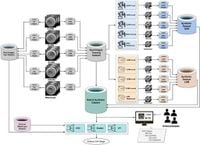In a significant advancement for assisted reproductive technology (ART), researchers have successfully integrated artificial intelligence (AI) into the embryo selection process, achieving a remarkable 97% accuracy in classifying embryonic cell stages. This breakthrough is vital in addressing the challenges posed by the high rates of infertility that affect approximately one in six individuals of reproductive age globally, as reported by the World Health Organization.
The study, published in Scientific Reports, demonstrates the power of synthetic data in overcoming the limitations of conventional embryo data that is often unobtainable due to privacy and ethical concerns. Notably, the researchers employed two generative models, the Latent Diffusion Model (LDM) and Generative Adversarial Network (GAN), to create artificial images of embryos at various development stages, including 2-cell, 4-cell, 8-cell, morula, and blastocyst stages.
Traditionally, the manual assessment of embryo quality by embryologists has been subjective and prone to error, often leading to unsuccessful implantation rates below 30%. By utilizing AI algorithms in embryo assessment based on comprehensive image data, the researchers aimed to enhance objectivity and improve ART outcomes.
In this study, the research team trained their classification models on both real embryo images and synthetic images generated through their advanced models. The incorporation of synthetic images not only expanded the dataset but also significantly improved the accuracy of stage classifications. When comparing models trained solely on real embryo images to those that included both real and synthetic images, there was a striking increase in performance—from 94.5% accuracy to the aforementioned 97% accuracy.
To validate the efficacy of their synthetic images, the researchers engaged four embryologists in a Turing test format, where embryologists had to distinguish between real and artificially generated images. The results were compelling: the diffusion model outperformed the GAN by deceiving embryologists in 66.6% of trials versus 25.3%, indicating a higher fidelity in the synthetic images produced. The low Fréchet inception distance scores achieved by the diffusion model further reinforced this conclusion.
This accomplishment underscores the dual significance of the study: it not only paves the way for more reliable embryo selection processes but also tackles the critical issue of data scarcity in the ART field. By creating a publicly available dataset of both synthetic and real embryos, the research team aims to facilitate future studies in reproductive healthcare technology.
Citing advancements in AI, the team noted that combining data from various generative models could offer enhanced classification capabilities. Their research aligns with prior findings indicating that the fusion of different synthetic data sources encourages improved model robustness by introducing diversity into the training processes.
The implications of this study are profound, as enhancing the embryo selection process could lead to increased success rates in ART treatments and improved patient outcomes. The integration of AI technology can complement human expertise, potentially transforming clinical practices in reproductive health by rendering them more efficient and objective.
As the landscape of ART continues to evolve with technological innovations, ongoing research will focus on further optimizing synthetic data usages while ensuring that AI applications maintain high ethical standards that prioritize patient anonymity and data protection.

